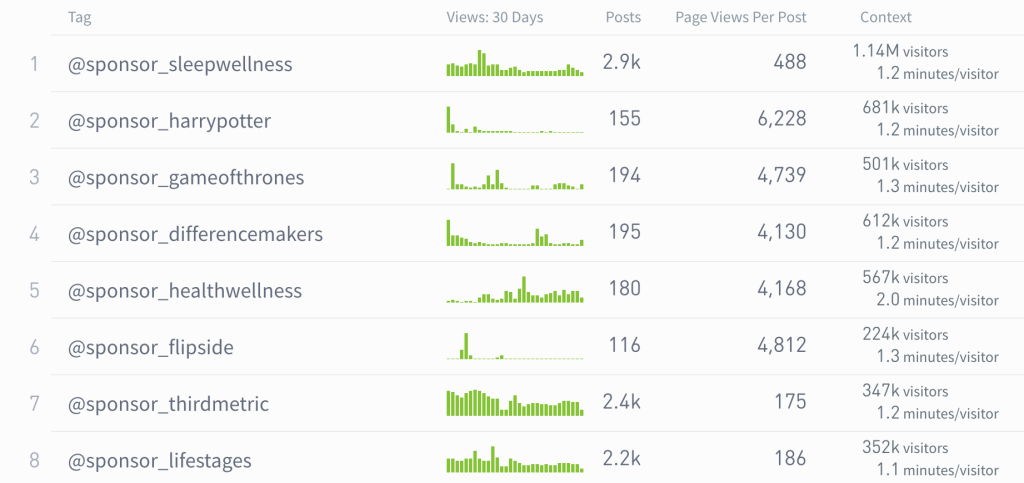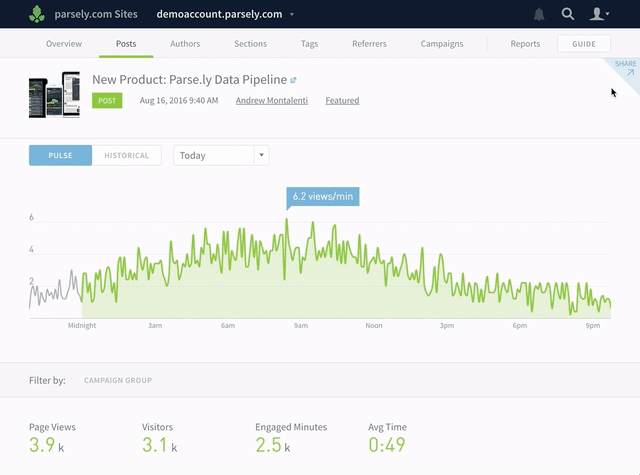How to Sell More Sponsored Content Using Data

An estimated $679 billion will be spent on advertising in 2023, much of it comprising native ads and sponsored content. And that number will only continue to grow in the coming years.
Behind those numbers are legions of sales and editorial teams, all vying to create impressive sponsored content campaigns that keep prospects coming back. Parse.ly’s Content Analytics dashboard has been a long-time companion to these teams, providing the audience engagement data that matters most.
Let’s talk about how they use our dashboard to sell more sponsorships and keep their clients happy.
- What is sponsored content?
- How Parse.ly helps prevent (and put out) fires
- Pitching: Prove the value of your audience to advertisers
- Running: Optimizing a campaign
- Reporting: Keep advertisers happy
- Save time and streamline the sales process
What is sponsored content?
Sponsored content is any material published and distributed in exchange for payment from an advertiser, typically to promote the advertiser’s brand, products, or services.
For simplicity, we refer to all types of paid content as “sponsored content.” This type of content is known by many names, including native advertising, branded content, and more.
Common examples of sponsored content include:
- Site takeovers
- Email sponsorships
- Digital display ads
- Print or broadcast packages
- Blogs or articles written by, or on behalf of, the sponsor
How Parse.ly helps prevent (and put out) fires
Let’s say your Ad Sales team sells a sponsorship deal. They come to your Editorial team and say, “We just sold a deal for $250,000, so now we need to deliver one million unique views related to content about farming in the month of March.”
That sounds great until Editorial reminds Ad Sales that March content has already been planned, “farming” is not a focus topic, and your site has never gotten that much traffic on farming content. Now you have to scramble just to fulfill the contract, likely wasting time and paid acquisition effort.
Putting out fires
If Ad Sales goes through with the farming deal, they can use Smart Tags in the dashboard to identify farming-relevant content Editorial hasn’t seen. By using natural language processing to target content topics, Smart Tags catch related, more subtle topics and groups that the human eye may otherwise miss.
In this example, Ad Sales sees Smart Tags identified topics like “livestock” and “weather” that actually do align with the prospect’s target audience.
This means Editorial has much less to worry about because Parse.ly’s intuitive data helps them find the right audience and content to target.

Things were resolved, but this fire drill could have been avoided entirely by using Parse.ly during the sales process.
Preventing fires
Regarding the farming deal, had Ad Sales checked Parse.ly, they would have learned Editorial didn’t publish much farming content, and what they did got little traffic. Armed with this intelligence, they would have wisely nixed the deal.
Meanwhile, Parse.ly could help Ad Sales dig even deeper using these features:
- Audience segmentation—provides a holistic view of site performance for a small, focused subset of users. Use case: Ad Sales chooses the subset closest related to the prospect’s target audience to determine a deal’s viability.
- Smart Tags—highlight the content and audience gaps. Use case: Ad Sales and Editorial learn about related content earlier so both teams work together on a solution.
- Campaigns—track traffic and distribution efforts across the site. Use case: Ad Sales identifies similar advertising campaigns (or a lack thereof) and how they’re performing, helping assess if a prospect is worth pursuing.
The best part? Parse.ly provides data that helps Ad Sales make better business decisions at every stage of the sales cycle.
Pitching: Prove the value of your audience to advertisers
When pitching to advertisers, how do you show your competitive edge? Look beyond pageviews to show the breadth and depth of your audience’s loyalty and interests
Our sales team goes out and pitches Slate’s loyal visitors and how much time they spend with our content. Establishing a relationship between engaged time and revenue generation helps frame why engaged time matters for more than only editorial.
Director of Research, Slate
Here are four metrics to prove the value of your audience.
#1. Engaged time
Identify the Section or Tag prospects are interested in and review engaged time for that topic. Longer engaged times show that readers are invested in your site content.
#2. Returning visitors
Understand audience loyalty using returning visitors. The more times readers visit, the more likely they are to trust the site and its advertisers and then convert.
#3. New visitors
Use new visitor data to prove the scope of audience reach and growth as well as the potential for clients’ campaigns to extend beyond existing audience bases into new demographics or channels.m
#4. Recirculation rate
The opposite of bounce rate, recirculation rate shows how engaged your readers are with your overall site, rather than with a single piece of content. A high recirculation rate means they’re reading multiple pieces of content, a great case for display ads, site takeovers, or other multi-content campaigns.
Running: Optimizing a campaign
It’s important that your sponsored content connects with its intended audience so you can fulfill your promise to your advertisers. Throughout the campaign, use Parse.ly to assess performance and make adjustments as needed.
Tags
Using tags, you can easily report advertising performance. In the example below, each advertiser has their own unique tag labeled “@sponsor_”, an easy way to sort advertisers.

Campaign tracking
Optimize your efforts by tying off-site distribution to on-site reader engagement with campaign tracking. From social to newsletters, learn which distribution channels and referrers have the best on-site engagement.
For example, maybe more pageviews come via Twitter but visitors spend the most time with your sponsored posts when they come from LinkedIn.
Based on the performance of your sponsored content across channels, you can adjust where you devote resources and optimize sponsors campaigns at every turn.
Reporting: Keep advertisers happy
Developing trust with advertisers is key in maintaining their business. We’ve developed multiple ways to do this, and save you time in the process!
One-click reporting
Set up a recurring, customized one-time report for each sponsor and email it to them. The Parse.ly reporting suite is also a hub for sales managers and campaign managers who want to track of multiple campaigns without logging into the dashboard.
Shareable links
Fortify your relationships with advertisers by generating live, real-time reporting links clients can bookmark and refresh to see how campaigns are performing.
Tip: Some Parse.ly customers provide these valuable reporting links as part of a campaign upsell.

Quickly create PDFs of what you’re looking at in Parse.ly with our new Print feature, part of the options for downloading and sharing data in the Parse.ly dashboard. Best of all, they’re easily shareable with clients, offering a detailed look at campaign performance.
Save time and streamline the sales process
Audience data in Parse.ly can help you uncover hidden sales opportunities and create hyper-relevant programs. Next time you’re putting together a media kit or pitch deck, use Parse.ly to identify similar, top-performing campaigns that will appeal to your prospects.
Not a Parse.ly Analytics customer? Contact us to get started.